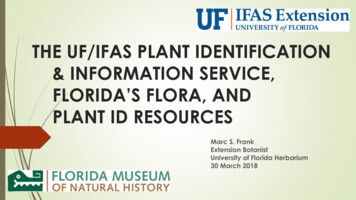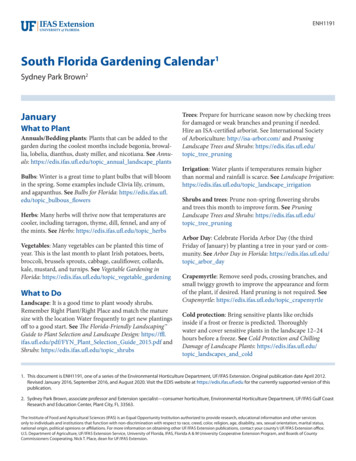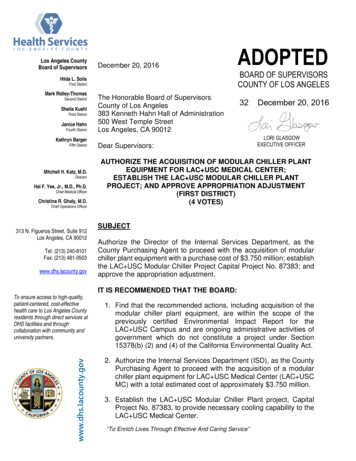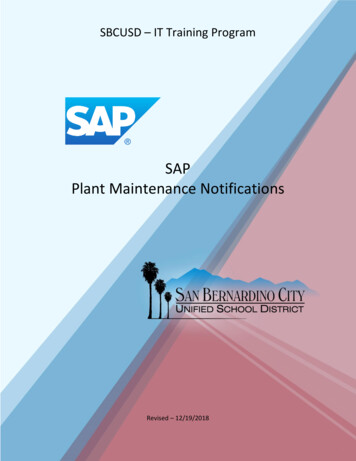
Transcription
THE UF/IFAS PLANT IDENTIFICATION& INFORMATION SERVICE,FLORIDA’S FLORA, ANDPLANT ID RESOURCESMarc S. FrankExtension BotanistUniversity of Florida Herbarium30 March 2018
The University of Florida Herbarium Established 1891, became part of the FLMNH in 1981 Approximately 500,000 specimens--the oldest, largest, and mostcomprehensive botanical collection in Florida 280,000 vascular plants (including 3200 vials of seeds) 160,000 mosses and liverworts 56,500 fungi (housed separately) 15,300 wood samples Library of over 16,000 books, journals, reprints, maps, andillustrations Includes specimens from every continent except Antarctica, butthe geographic focus is circum-Caribbean Constantly growing ( 2500 specimens/year)
The UF/IFAS Plant Identification andInformation Service Established1927 as a service to FloridaCooperative Extension personnel Currently funded by UF/IFAS and the FloridaMuseum of Natural History Provides authoritative IDs of vascular plants,plant-related information, andeducational/outreach presentations Serves UF/IFAS, the university community, and thegeneral public
The Process of Plant IdentificationRecognition (visual memory)vs.Diagnosis and verification
Why bother identifying a plant? An accurate pest and host ID is the first step in anyintegrated pest management program An ID is critical when determining if a plant isregulated by law, regarded as invasive, and whethercontrol is warranted Knowing what a plant is helps you accessinformation that will improve success in cultivation An accurate ID allows you to access a wealth ofinformation about the plant such as nativedistribution, potential invasiveness, regulatory status,toxicity, cultural requirements, economic uses, etc.
How to get plants identified?1) Submit a physical sample(fresh or dried/pressed)2) Send photos via email3) Submit a digital sample via the DistanceDiagnostic and Identification System (DDIS)Remember: Your local cooperative extensionoffice is the best place to go when you needa plant identified or advice how to grow orcontrol it
Collecting Plant Samples for ID Flowering/fruiting samples are mostdiagnostic At the very least we need to see severalwhole leaves attached to a stem If the plant is badly infested or damagedby insects or disease, try to find a relativelyundamaged piece to send as a sample
Collecting Plant Samples for ID To minimize wilting and defoliation, onceyou’ve collected the plant sample put it in asealed plastic bag, and keep it out of theheat and direct sunlight until you are able tosend it or press and dry it Bagged samples may be refrigerated untilthey can be shipped, but refrigeratedsamples that are subsequently subjected tohigh heat seem to rot very quickly!
Challenges!The process of diagnosis ismuch more challenging andtime-consuming when theplant sample is very small,sterile, wilted, fragmented, ordecomposed
The Sample Submission Form (for physical 00.pdf
Submitting photos by email Identifying plants from photos is challenging, so itis especially helpful if you include the samelocation, context, and plant descriptioninformation that you would provide on a samplesubmission form Please be sure to tell us what county the plant isgrowing in. If the plant was photographed out ofstate or out of country, it is very useful if you tellus where!
Submitting photos by email Generally a single photo is not sufficientfor confident identification. Try to take: a photo of the entire plant a close-up of the stem with leaves (sowe can see leaf arrangement) a close-up of flowers or fruit Include a ruler, coin, or person in thephoto for scale if possible
Submitting photos by email:photo quality is very important! Make sure your photos are in focus andthe plant you want identified is clear andobvious, not obscured by glaring sunlightor shade Photos need to be high enough resolutionthat we can zoom in and see plant detailswithout the image become pixilated
Examples of photos showing diagnostic characteristics:
Examples of photos of limited diagnostic value:
Florida’s Vascular Flora 4300 plant species native or naturalized(ranked 6th most diverse in USA)—representing 243 plant families 3000 native species 1300 naturalized species 10,000 plant species cultivated in Florida
Florida’s Native Flora3000 native plant species 230 endemic 553 species protected by the FloridaDepartment of Agriculture, Divisionof Plant Industry 431 endangered 114 threatened 8 commercially exploitedFor more information about Florida’s protected plants ida-s-Endangered-Plants
Florida’s Naturalized Flora 1300 naturalized plant species 150 invasive (FLEPPC) 100 regulated (prohibited by law)by the Florida Department ofAgriculture, Division of Plant Industryas noxious weeds or prohibitedaquatics plantsFor more information about Florida’s prohibited plant species ous-Weeds
Florida’s Cultivated Flora 10,000 cultivated plant species Includes ornamentals, fruits,vegetables, herbs, forage crops,turfgrass, and more! Ranges from temperate species in thenorthern panhandle to tropical specieson the southern peninsula
Florida’s Vascular Plants:243 Native/Naturalized Plant Families!Graphic from Atlas of Florida’sNatural Heritage 2011, FloridaNatural Areas Inventory
Florida’s Top Six Plant Families:No. 1: Poaceae (the grass family) Approx. 121 genera & 454 species native ornaturalized in Florida Pollinated by wind, so flowers are generallysmall, inconspicuous, lacking petals This family is of great economic importance-providing most of the cereal grains on whichcivilization is basedFor more info on landscape grasses forFlorida see Native Bunchgrasses: A NaturalAlternative To eetbgrass.pdf
Florida’s Top Six Plant Families:No. 2: Asteraceae (the aster family) Also known as Compositae, which alludes to thefact that what appears to be a single flower isactually a head consisting of many tiny flowers Approx. 140 genera & 435 species native ornaturalized in Florida Mostly herbaceous, varied in form
Florida’s Top Six Plant Families:No. 3: Fabaceae (the legume family) Also known as Leguminosae Approx. 91 genera & 334 species native ornaturalized in Florida Extremely diverse in habit, including herbs,shrubs, trees, and vines
Florida’s Top Six Plant Families:No. 4: Cyperaceae (the sedge family) Approx. 17 genera & 280 species native ornaturalized in Florida Sedges are similar to grasses in appearance, butcan be distinguished by their triangular stemswith solid pith (grasses have round, hollow stems) Most common in wet habitats
Florida’s Top Six Plant Families:No. 5: Orchidaceae (the orchid family) Approx. 56 genera & 119 species native ornaturalized in Florida Exclusively herbaceous, both terrestrial andepiphytic in habit Flowers are highly specialized for insectpollination
Florida’s Top Six Plant Families:No. 6: Lamiaceae (the mint family) Approx. 41 genera & 118 species native ornaturalized in Florida Includes both herbaceous and woody species Many with aromatic oil glands in leaves, someused as culinary & medicinal herbs
Plant Identification Resources: Online Atlas of Florida Plants: http://florida.plantatlas.usf.edu/ Searchable by scientific name or common name or browse by plantfamily Includes county distribution maps and often images Includes only those species that are native or naturalized in Florida Links to specimen images from the USF Herbarium The University of Florida Herbarium—digital imaging /cat/imagesearch.asp Searchable by scientific name, common name, plant family, orproject/thematic sets High resolution scans zoomable to 10x magnification Currently only 60,000 of the 280,000 vascular specimens in the UFHerbarium have been scanned
Plant Identification Resources:Printed General Botany References W.B. Zomlefer 1994 Guide to Flowering Plant Families. University of North CarolinaPress. J. L. Castner & J.R. Abbott 2005 Photographic Atlas of Botany & Guide to PlantIdentification. Feline Press. J.G. Harris & M.W. Harris 2001 Plant Identification Terminology: An IllustratedGlossary (2nd ed.). Spring Lake Publishing.
Plant Identification Resources:Printed Florida References (academic) R.P. Wunderlin and B.F. Hansen Guide to the Vascular Plantsof Florida (3rd ed.). University Press of Florida. R. Wunderlin & B. Hansen 2000-2017 Flora of Florida (4 of 10volumes published so far). University Press of Florida.
Plant Identification Resources:Printed Florida Reference (field guides) D.W. Hall & W.J. Weber 2011 Wildflowers of Florida and the Southeast. D.W. HallConsulting. J.C. Daniels & S. Tekiela 2010 Wildflowers of Florida Field Guide. AdventurePublications. W.K. Taylor 2013 Florida Wildflowers: A Comprehensive Guide. University Pressof Florida. G. Nelson 2010 The Trees of Florida. Pineapple Press. G. Nelson 2000 The Ferns of Florida. Pineapple Press. G. Nelson 1996 The Shrubs and Woody Vines of Florida. Pineapple Press.
Plant Identification Resources:Cultivated Plants (temperate) Alan M. Armitage: Armitage’s Garden Annuals: A Color Encyclopedia. 2004 Timber Press. Armitage’s Manual of Annuals, Biennial, and Half-Hardy Perennials. 2001 Timber Press. Armitage’s Garden Perennials (2nd ed.). 2011 Timber Press. Herbaceous Perennial Plants (2nd ed.). 1997 Stipes Publishing. Michael A. Dirr: Manual of Woody Landscape Plants. 1998 Stipes Publishing. Dirr’s Trees and Shrubs for Warm Climates. 2002 Timber Press.
Plant Identification Resources:Cultivated Plants (tropical) K.A. Llamas 2003. Tropical Flowering Plants: A Guide to Identification andCultivation. Timber Press. M. Barwick 2004. Tropical and Subtropical Trees: An Encyclopedia. Timber Press. G.W. Staples & D.R. Herbst 2005. A Tropical Garden Flora. Bishop Museum Press. R.L. Riffle, P. Craft, and S. Zona 2012. The Encyclopedia of Cultivated Palms (2nd ed.).Timber Press.
QUESTIONS?
information that will improve success in cultivation An accurate ID allows you to access a wealth of . northern panhandle to tropical species on the southern peninsula. . Tropical Flowering Plants: A Guide to Identification










